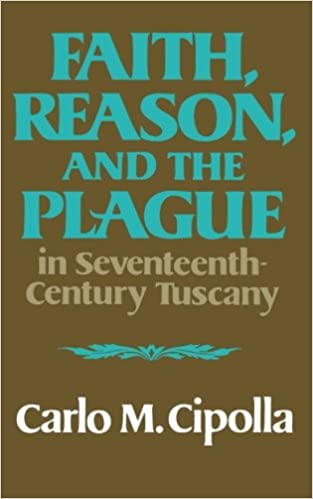Carlo M. Cipolla
Muriel Kittel (translator)
W.W. Norton & Company
New York
1979
113 pages
According to the Art:
Cipolla’s account of the bubonic plague striking Northern Italy in 1630 shows how epidemics drive people into opposing groups, in this case, Church and State. The 2020 pandemic shows that epidemics still drive people into opposing groups.
Synopsis:
Carlo Cipolla chronicles the 1630 bubonic plague outbreak in Northern Italy. At various places in the text, he refers to his compact volume as an “essay,” a “tale,” and a “book.” Readers during the 2020 coronavirus pandemic could call it a “prologue,” a “warning,” or a “horror story foretold.”
The plague ravaged much of Northern Italy from 1630 to 1631. Cipolla focuses on a particular village, Monte Lupo, because “so exceptionally rich is the documentation of [its] story that it allows the historian to recapture emotions, attitudes, and behavior of common people.” The documentation led him to uncommon detail “on the relationship between Faith and Reason, Church and State at a social level.” (p. ix)
Reading like an historical essay, Cipolla first sets up the tensions arising between the Church and the State during the plague epidemic. The “scientific revolution” had advanced enough by 1630 that regional Health Magistrates acted based on experience rather than faith. Most clergy and their followers still “preferred to believe rather than observe…[and] had not the slightest doubt: processions and similar ceremonies were the only way to placate divine wrath and put an end to the scourge.” (p. 7) But, the divide between Church and State in this case is not so clear as that, Cipolla notes, because some of the senior Health Magistrates served as high-ranking church leaders themselves.
Cipolla points to public health measures taken in Northern Italy before the 1630 plague outbreak that might have, ironically, heightened tensions, even though they were born from the terror and suffering epidemics caused during the previous two centuries. The changes that resulted were, in Cipolla’s view, “a strange mixture of brilliant intuition, sound common sense, and absurd prejudice.” (p. 12) However rational these measures seemed, “they caused great misery and severe privations [through] the segregation of entire families in their homes, the separation of kindred in the horror of the pesthouses, the closing of markets and trade, the consequent lack of work and wide-spread unemployment, the burning of furnishings and goods.” (p. 13) By the time the plague took hold in 1630, necessary public health measures were already unpopular.
Cipolla uses the walled-village Monte Lupo as his case study. Around 150 families lived inside its walls when the plague struck during the summer of 1630. He details how Health Magistrates struggled to gain control of the outbreak while facing open rebellion fueled by “ignorance, egoism, avarice, and bullying.” (p. 14) He names and profiles key figures and describes various events.
The central event in Cipolla’s tale is a “procession” in Monte Lupo featuring a crucifix people believed had “miraculous properties.” (p. 41) The Health Magistracy took aggressive actions to prevent and then stop the procession. Alas, Cipolla reports: “All this was in vain. It was like preaching to the wind: the church was soon packed with men and women, boys and girls, who had come to gaze at and adore the crucifix.” (p. 47) Festivities carried into the evening and on to a neighboring town (San Miniatello). Mayhem, illness, and death ensued.
The last death in Monte Lupo occurred on August 11. Cipolla follows the subsequent investigations searching for people encouraging exposure to a lethal, contagious disease, and for people who became infected and died as a result. He reflects on the juxtaposition of epidemiological methods used to stop the epidemic and the fight religious leaders and followers waged against them. He muses about “emotions, attitudes and behavior of all segments of a society in a period distant in many ways from our own.” (p. 85) Written in 1977, the objects of his musing were only four decades distant from becoming evident again.
Analysis:
Cipolla’s account of the Monte Lupo bubonic plague epidemic shows how an infectious epidemic drove people into groups based on beliefs or knowledge, or as he put it, faith or reason. His observation held for the 2020 pandemic when it also drove people into groups based on faith and reason, but also based on attitudes, identities, and affiliations.
Groups defined by opposing positions on matters of life and death can stir hostilities. Cipolla recounts many times where the Health Magistracy squared off with Monte Lupans. In one case a surgeon in the service of the Health Magistracy became “afraid to go about the [village] without a [gun].” (p. 44) Even priests organized upheavals aided by “a threatening populace ready to lend strong hands”—LIBERATE MONTE LUPO! (p. 49). Standoffs persisted until one side relented, and the health officials most often gave way. The very same attitudes and responses are seen four-hundred years later. Groups against public health rules stormed state capitols—LIBERATE MICHIGAN!
The effects from what occurred in Monte Lupo foretold the horrors seen in 2020. The procession and festivities in Monte Lupo drew crowds from neighboring towns. The names of many who attended showed up on subsequent death notices. Likewise, the names of many who attended 2020 presidential campaign events, massive motorcycle rallies, stadium-size wedding ceremonies, and the like, became casualties of the horror show previewed in 1630.
Cippola adds to the vast volume of plague related literature spanning centuries, showing once again, with infectious epidemics, past is prologue.
Also:
The 1630 plague epidemic in Northern Italy is also featured in the literary novel, The Betrothed, by Alessandro Manzoni. I compare statements and events of that outbreak with statements and events of the 2020 pandemic here.
A version of this post is available at the NYU Literature, Arts and Medicine Database.



